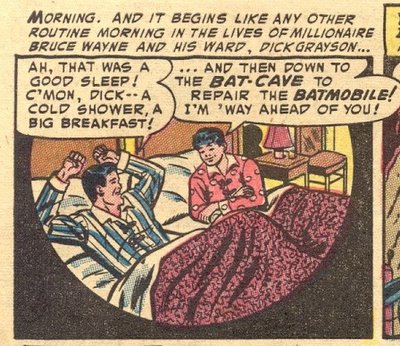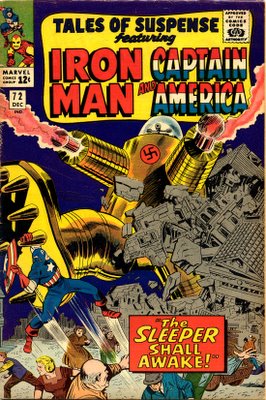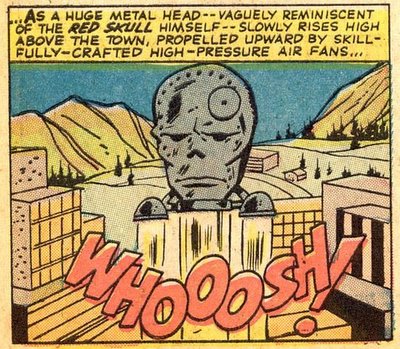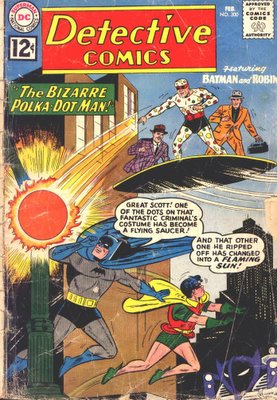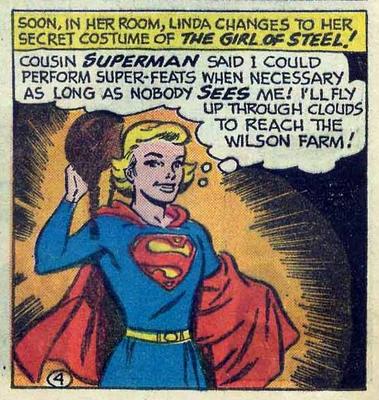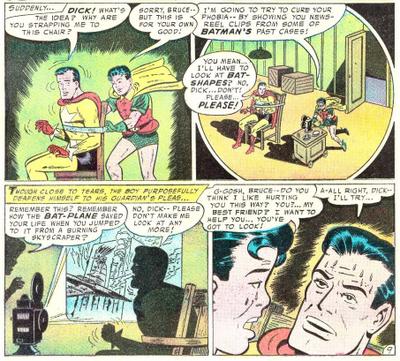(Note to readers: This is a substantial reworking of the original post, which has now become the #1 result on Google for "Batman and Guns" and linked by many online forums. The original post was assembled over time and included numerous corrections appended to the text. Since this has become an authoritative source, I have decided to revise the entire post. Thanks to my commenters who came up with corrections and additions!)
One of the more famous elements of Batman's mystique has always been his refusal to use guns. Of course, those of us familiar with the early stories know that this was not always the case, and over the years the writers, artists and editors have frequently forgotten this key aspect of the character.
First up is Detective #32. This story is basically a take-off of the movie "Dracula". Bruce Wayne's girlfriend, Julie Madison, is under the spell of a vampire. Batman trails the vampire and its female assistant to their castle and shoots them each with a silver bullet:
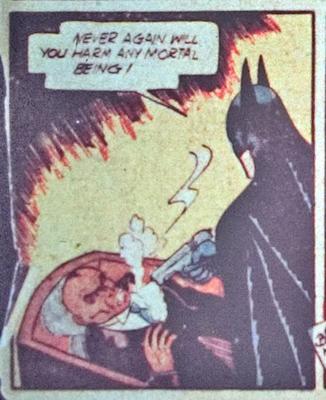
The first time Batman was shown with a gun on the cover of a magazine is supposedly this image from Detective #33:
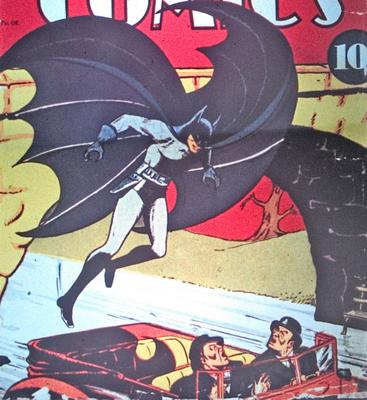
At least, it's usually considered a gun; to my eye it looks more like a knife on his belt. Detective #33 was also the first comic to present the now-familiar origin of the Batman:
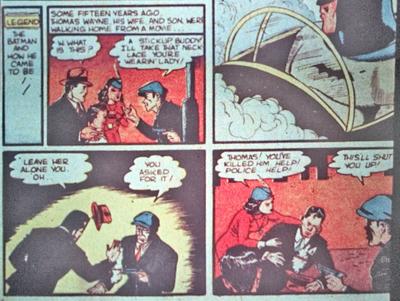
So the phobia against weapons is certainly understandable. But in the story, Batman uses a gun (apparently the one on his belt) to shoot at some "ray" machines:

And the ending of the story has a startling panel:

Batman did appear with guns on two World War II covers:


Clearly special cases, although the first one does show him firing a gun.
From Detective #35 comes the most extreme panel of Batman with a gun in the first 40+ years:

You can sense that's just a little bit too far, but this was the second superhero of all time, and the code of conduct that superheroes didn't kill hadn't been developed. Oddly, the splash shown above does not appear in the story and Batman does nothing else with a gun in this issue.
Batman used a gun in Detective #36, but it was to summon the police to pick up some thugs he had kayoed.

However, it is not explained where the gun came from.
The next major incident involving Batman and guns came in Batman #1. Hugo Strange had made monsters out of men by giving them a growth hormone. Batman tracks down the truck the monsters are riding in and:
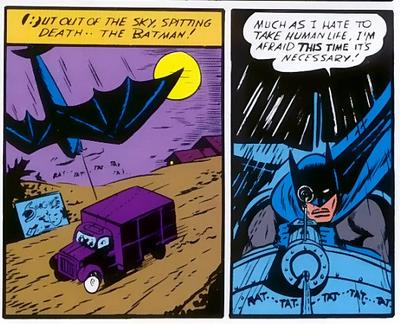
Reportedly it was this sequence that resulted in an editorial edict against Batman killing. Both Batman and Robin had been fairly casual about tossing crooks off large buildings to their apparent deaths, and in a notorious sequence Batman had toppled an idol on some Chinese thugs in Detective #39. The sequence in Batman #1 was to be the last time that Batman intentionally killed someone, although it was far from the last time he used a gun.
The next time he used a gun, it was to wing a machine-gunner:
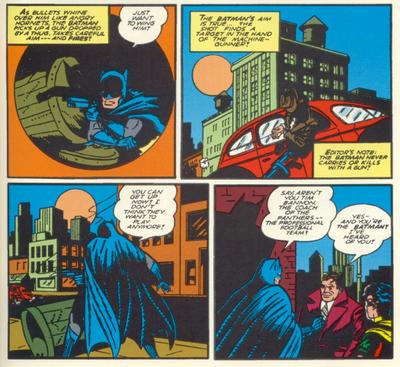
Get the editor's note: "The Batman never carries nor kills with a gun!" But he's happy to pick one up and cap a few rounds. ;)
In Batman #7, our hero was finally accepted by Commissioner Gordon, who gives an impassioned speech including mention of the gun ban:

Maybe the oddest bit with Batman and guns comes in Batman #21. A cattle rustler has kayoed Batman and fed him loco weed. When Robin and the local sheriff revive him, he steals a gun from the latter and:

For most of the next several decades, the only times Batman used a gun was for shooting something other than a person:

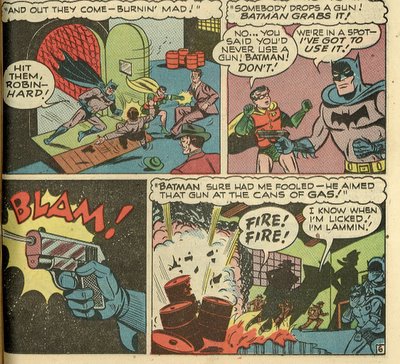
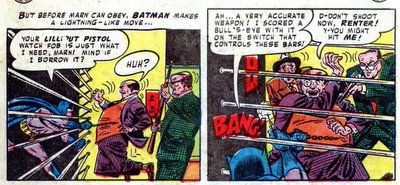
In Detective #65, Batman shows that whatever his opinion of firearms, he's still a crack shot:

However, in Detective #260's The Mystery of the Space Olympics, Batman is surprised when he shoots well to win a competition:

Here's an odd panel from World's Finest #39, where a mystery writer thinks he's deduced Batman's secret identity and confronts Bruce at his home. Why would a man whose aversion to guns is nearly phobic, have a brace of pistols mounted on the wall?
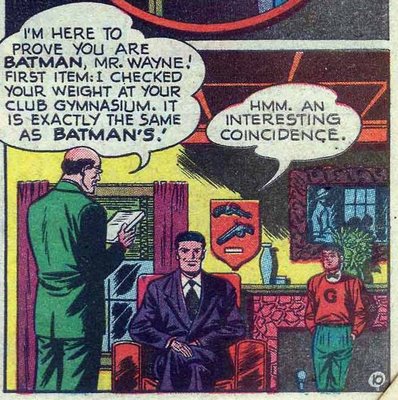
In Batman #55, Bruce Wayne and Commissioner Gordon are captured by mobsters, but they manage to turn the tables here:

Here's a similar theme from Detective #327 (May 1964) in Carmine Infantino and Julius Schwartz's first "New Look" Batman story:

Batman does the cliched "my pipe is a gun" routine here:
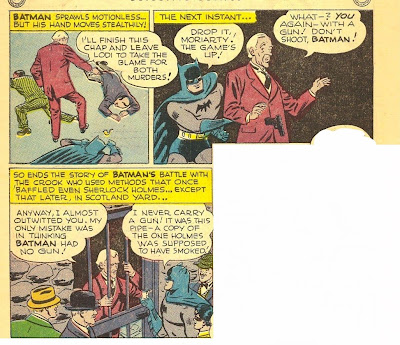
In Batman #65 Bruce Wayne takes a job as a crime reporter, but he's still determined not to use a weapon:
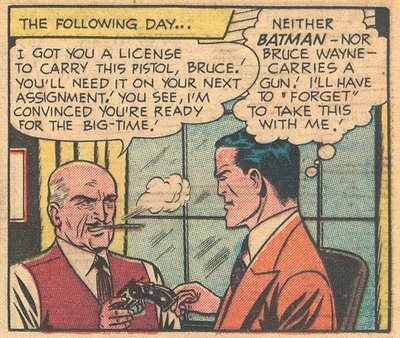
Of all the people Batman might shoot, taking a point-blank shot at Commissioner Gordon is probably one of the least likely, but it happens in Detective #121 (May 1947):
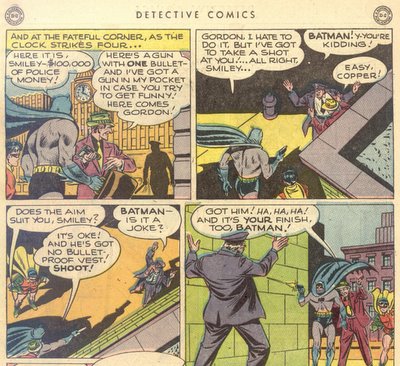
In the story Batman has wagered a bet-happy villain $100,000 of the cops' money that he will shoot a gun straight at Commissioner Gordon's heart. As it turns out, Batman has an invisible bulletproof glass shield between him and the Commish.
On the other hand, we might expect Batman to be willing to shoot at the Joker, and here's a rare example (from Batman #97) of our hero with a gun in the Silver Age:

We can see the Joker has a parachute, so he will not die.
In Batman #99, a reporter discovers an old newspaper clipping that appears to accuse Batman of shooting a crook:

Batman and Robin go back in time courtesy of Professor Nichols to discover what really happened. After foiling an attempt to rob a train, Batman is chosen as the local marshal:

But a little later, a new marshal shows up with a very similar name, resulting in the headline:

In Batman #129, a letter writer asked:

In Detective #404, Batman uses a rifle to shoot some dolphins:

Dolphins? Yep, in the story the dolphins are carrying plastic explosives designed to blow up the yacht of a shipping magnate.
From Detective #256 comes another example of Batman refusing weapons:
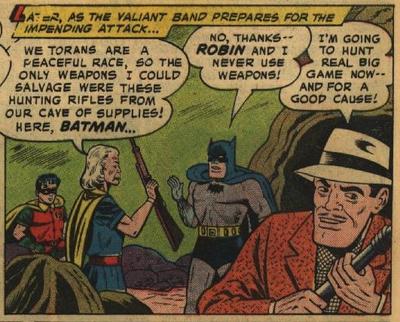
Although in other stories like this example from Batman #4, Batman discusses the need to be proficient in all types of weapons:

And here with Robin #2 (Jason Todd):

But apparently not with knives, as this panel from Batman #57's famed
Ride, Bat-Hombre, Ride states:

Here's the only other panel I could find of Robin shooting a gun so far:

Hard to tell what's really going on there; looks like Robin's supposed to be shooting a skeet-shooter, which of course looks little like the rifle he's shown using there.
Batman turns down a gun from a pretty famous source here:
Detective #417 includes this scene:

But the crook is right; the guy in the suit (a George Plimpton type) writes about what it's like to be some famous athlete or personality, and unfortunately Batman (who's in on the impersonation) forgot to inform him about the "no guns" rule. Hat Tip: comicsdork. Batman uses a gun-like laser in this story from Brave & Bold #78:

Along the same lines is this "sonic gun" used on the Man-Bat:

Detective #444 came with this grabber of a cover:

It was all apparently a complicated plot by Talia and her father, Ra's Al Ghul, to get Batman wanted by the cops so he would accept their offer to join them. Micro-circuitry automatically fired the bullets, which contained a narcotic that simulated death. Thus Talia wasn't really dead and Batman hadn't really fired the gun at her.
From Detective 453 comes this example of the prohibition of the use of guns carried to a ridiculous extreme:

Why would he refuse to shoot a gun into the floor? As it happens, instead of doing that he hurls the gun into the TV screen.
Batman #301 featured this startling cover:
It's a very convoluted story; suffice to say that Batman took the rap for murdering the man on the cover (a crime boss) in order to protect others.
In the mid-1980s, Frank Miller's influential but bleak Dark Knight Returns series included this scene where Batman responded to a kidnapper threatening to kill an infant:
Detective #575-578 featured the Batman Year Two storyline, in which our hero considers arming himself. Each of the covers featured Batman with a gun; I'll show only the first:

In the modern era, editors, writers and artists all have continuity guides to prevent their making a mistake, right? In Detective 627 (the 600th issue since Batman's beginning) this sequence appeared:


A major no-no.
The cover of Detective #710 shows Batman with a gun again:

In the story, the greatest assassins in the world have descended on Gotham to get revenge for a dying old man. Batman defeats a sniper on a rooftop, only to find that another killer is on a ship, ready to kill a bunch of people, in sniping range but otherwise unreachable. What can he do?
He's the goddamn Batman:

From the hip, no less. Cute story, but a bit too obviously set up to force Batman to shoot. Later, Alfred regrets that Batman didn't get the gun for the collection room but Bruce is not interested:

In the newest (January 2009) DC comic, Final Crisis #6, Batman confronts Darkseid:

This of course sets the stage for the death of Batman (at least as Bruce Wayne). Apparently.
Some of the stories mentioned in this post can be purchased here:

